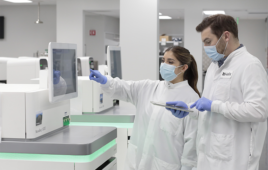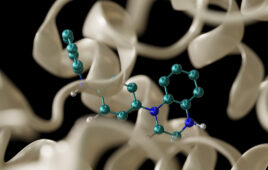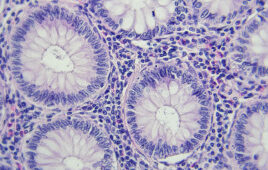Functional proteomics, powered by mass spectrometry, leads the way to the identification of better biomarkers.
The search for proteins of clinical significance—biomarkers—has driven increasing interest in identifying groups or networks of proteins, and learning their functions. Functional proteomics can be carried out through a variety of methods, such as mass spectroscopy, gel electrophoresis, chromatography, or novel emerging technologies. Because of the quantity of data produced by functional proteomics studies, sophisticated computer analysis is also an integral part of the approach.
Functional proteomics is a systems-based approach that takes into account relationships between molecules, looking at both the ‘big picture’ (i.e., the overview of network relationships) and the minutiae of spatial or mechanical interactions between the molecules. Functional proteomics looks at both the forest and the trees, using an understanding of underlying mechanisms of disease to develop new hypotheses.
Functional proteomics is the younger sibling of functional genomics, and, in fact, the two studies can be carried out successfully in parallel. Although functional genomics is, in theory, about the function of genes, in practice, it focuses more on expression analysis of genes. Expression patterns, however, can only give limited diagnostic or prognostic information. Tests based on functional genomics studies tend to predict risk of disease rather than diagnose actual disease. N. Leigh Anderson, PhD, founder and CEO, of the Plasma Proteome Institute in Washington, D.C., advocates the identification of protein biomarker candidates through genetic sequencing, followed by proteomics analysis using multiple platforms (Anderson NL. The Roles of Multiple Proteomic Platforms in a Pipeline for New Diagnostics. Molecular and Cellular Proteomics. 2005; 4(10):1441-1444). This is because there is a broad range of abundance of proteins in nature, meaning that any single proteomics technology could miss a significant molecule.
Weighty matters
Mass spectroscopy is the heavyweight, so to speak, of proteomics research. A unique feature of the method is that it has the ability to be used in both phases of functional proteomics research. First, you can use mass spectroscopy to create a profile of proteins for a specific disease. Second, you can use mass spectroscopy to discover the functional relationships between proteins.
Radoslav Goldman, PhD, an assistant professor in the Department of Oncology at Georgetown University, Washington, D.C., studies molecular indicators of disease progression. One of his research interests is the progression of hepatitis C to liver cancer. In a fraction of patients with hepatitis C, the virus progresses to chronic liver disease and cancer. “It’s not clear which infected people will progress to the endpoint of having cancer,” says Goldman. “The expectation is that by looking at proteins or other molecular markers, we could have a better understanding of the disease progression.” Goldman used LC MALDI-TOF mass spectroscopy in two ways for these studies—looking at peptides and also at glycans. “For example, in the case of liver cancer, we’ll take a group of patients which are infected with the virus, a group of patients which developed liver disease, and a group of patients who already have cancer, [and look at] how they differ in terms of peptides secreted by the liver … we look also at how glycosylation of the proteins changes.”
Preliminary results of this research have yielded a list of peptides and glycans that can predict the presence of liver cancer with approximately 90% accuracy. This is better than the best currently available clinical marker, alpha-fetoprotein. (Isailovic D, Kurulugama RT, Plasencia MD, Stokes ST, Kyselova Z, Goldman R, Mechref Y, Novotny MV, Clemmer DE. Profiling of Human Serum Glycans Associated with Liver Cancer and Cirrhosis by IMS-MS. J Proteome Res. 2008 Feb 1 [Epub ahead of print].)
Affinity- and array-based methods
One major disadvantage of mass spectroscopy is that it cannot handle the full range of relative abundance of clinically-relevant proteins. That range spans about 12 orders of magnitude, and typically mass spectroscopy can look at 3-4 logs of concentration simultaneously. For obtaining the broadest possible range of protein concentration, affinity-based methods can be a good choice.
At Invitrogen’s Protein Array Center, Branford, Conn., researchers use a new protein array technology to perform functional proteomic studies. These are not antibody arrays. Rather, they are arrays of actual proteins, spotted onto nitrocellulose membrane. Each array contains 8,000 recombinant human proteins, distributed throughout many functional classes. The protein array can be used for a number of proteomics applications, including studies of protein interactions, enzyme-substrate profiling, small molecule interactions, or biomarker discovery.
One major application of the protein array is to identify key signaling molecules. Protein arrays have been used to find proteins phosphorylated by specific kinases, sketching out new pathways for signal transduction. By exposing the entire array to a kinase, one can quickly pick out proteins that are modified by that kinase, often with interesting surprises.
Ubiquitin is another important molecule in signal transduction and protein regulation that can be studied using a protein array. Barry Schweitzer, PhD, director of R&D and site leader, Invitrogen Protein Array Center, comments, “It’s a brand-new, hot area, a totally new class of druggable targets. There’s not really a lot known about which proteins are modified by ubiquitin. We’re unique in that we have the ability to profile in a single experiment 8000 proteins to see which ones might be substrates for a particular enzyme.”
The 8000-protein collection was assembled based on Invitrogen’s collection of fully-sequenced, open reading frames from humans, cloned into gateway cloning systems. This is a logical extension of functional genomic studies, taking the identification of genes of interest to the next level—finding pathways, and then learning the functions of individual proteins in the pathway.
| ProtoArray content |
Protein Distribution by Selected Class |
| Protein kinases |
378 |
| Transcription factors |
188 |
| Membrane proteins |
1085 |
| Nuclear proteins |
830 |
| Signal transduction |
710 |
| Secreted proteins |
100 |
| Cell communication |
863 |
| Metabolism |
2166 |
| Cell death |
145 |
| Protease/peptidase activity |
138 |
| A distribution of proteins present on ProtoArray Human Protein Microarray v4.0 arranged by functional class. These classes are not necessarily mutually exclusive, so some proteins may fall into more than one class. (Source: Invitrogen) | |
Another example of functional genomics working hand-in-hand with functional proteomics is the Aryl Hydrocarbon Receptor (AHR) collaboration between the Functional Genomics Research Program at The Hamner Institute for Health Sciences, Research Triangle Park, N.C., under Russell S. Thomas, PhD, Director, Functional Genomics Program, and the laboratory of John LaPres, PhD, associate professor, in the Department of Biochemistry at Michigan State University, East Lansing, Mich. Says LaPres, “What we’re really trying to do is identify all of the proteins that bind to the aryl hydrocarbon receptor in a couple of tissue types.” They use multiple proteomic methods, including high-throughput mass spectrometry and tandem affinity-tagging to find the proteins. “That’s our ultimate goal … get these proteins, and work with someone like [Russell Thomas] and develop an actual model for how these proteins signal in the presence and absence of something like TCDD.” TCDD, or 2, 3, 7, 8-tetrachloryldibenzylteradioxin, is an aromatic hydrocarbon that activates the AH receptor.
Human plasma contains an estimated 1,175 proteins, many of which have unknown functions (Anderson NL. The Human Plasma Proteome: A NonRedundant List Developed by Combination of Four Separate Sources. Molecular and Cellular Proteomics. 2004; 3:311-326.). By interrogating the proteome for interrelationships, pathways, and networks, researchers can gain important functional and mechanistic insights into both normal and disease processes. This insight can yield direct benefit in terms of clinical biomarkers of disease, and it also has inherent value for all of science. However, proteomics is complicated by a vast range of relative abundance, and functional proteomics has not yet developed a set of common standards for experimental methods. Moreover, discoveries made in one laboratory, or with one set of techniques need to be validated in a universally-relevant manner before they can be fully exploited. Says LaPres, “I think the field needs to set some criteria—if you will—or some way of establishing standards for these kinds of studies. This field is in the same place genomics was five or 10 years ago … these standards are starting to come out already.”
About the Author
Catherine Shaffer is a freelance science writer specializing in biotechnology and related disciplines with a background in laboratory research in the pharmaceutical industry.
This article was published in Drug Discovery & Development magazine: Vol. 11, No. 3, March, 2008, pp. 44-46.
Filed Under: Genomics/Proteomics





